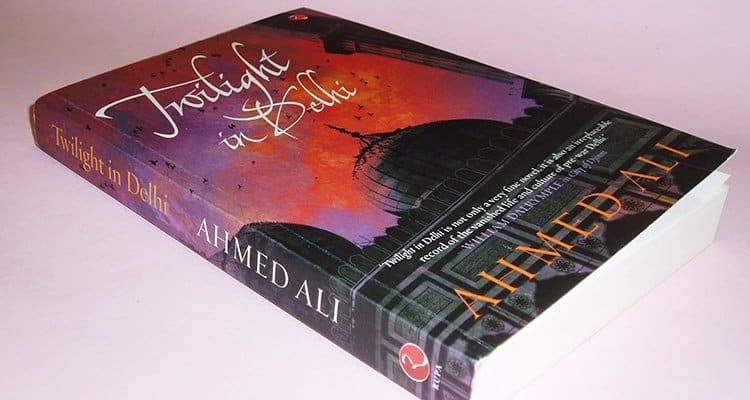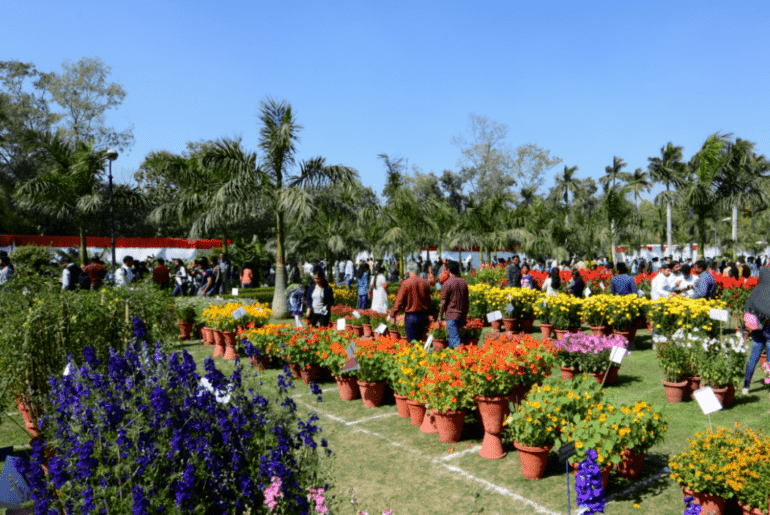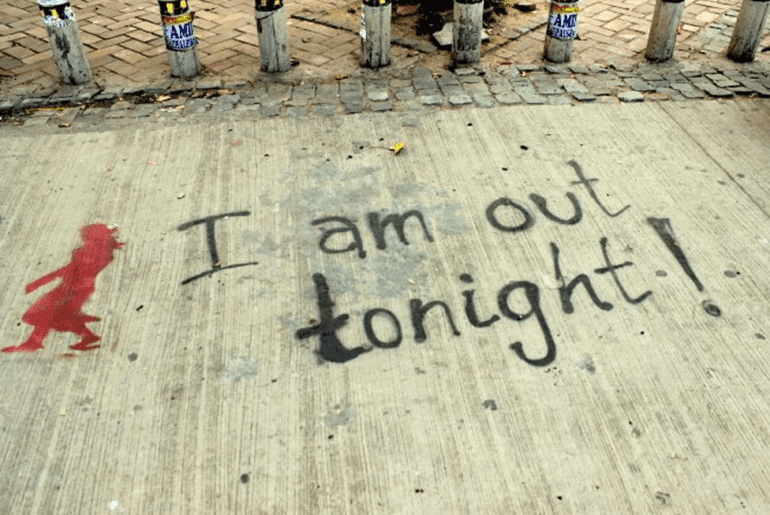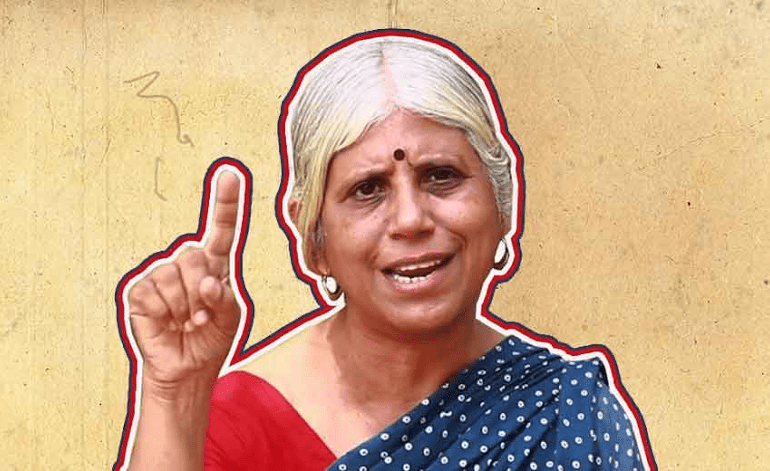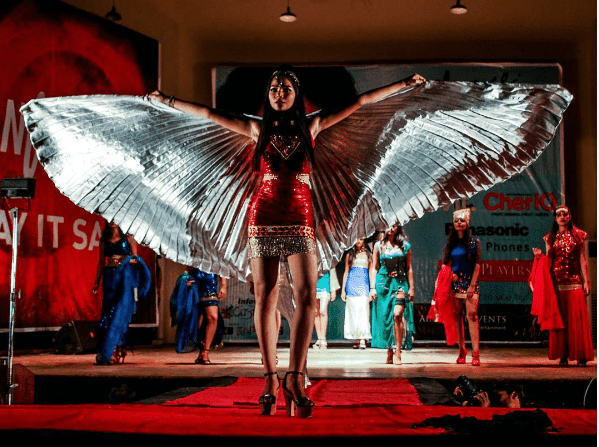Delhi University has all sorts of societies to accommodate various talents, be it drama, dance, debate, photography or even the most glamorous of them all: fashion. When one visualizes fashion, one thinks of spotlights, high heels and flawless models. Anyone who has had the luck of witnessing a DU fashion society perform can affirm that such performances scream confidence and ooze glamour. However, underneath the makeup (and what phenomenal make up it is!) and costumes, simmer hours of rehearsals and meticulous conceptualizing, a fact that people are unaware of.
Themes and Dresses
Before preparing for the ramp, it’s the dresses and props that are designed and this is not about randomly assorting an array of garments.Rather, everything is made exclusively on the basis of a theme.
The Institute of Home Economics’ fashion society Poise has won praise for their awe-inspiring and graceful performances on themes such as ‘Palace of Illusions’, which showcases the Mahabharata through Draupadi’s eyes (it must be inspired by Chitra Banerjee Divakaruni’s book of the same name) and ‘Naqaab’, which depicts multiple personality disorders.
‘Prophecy’, the fashion society of Lady Irwin College prides itself for interesting interpretations of topics such as ‘Circus’ and ‘Gods and Men’. Their most famous creation was ‘Contemporary Cleopatra’s Eviction’, which is a recreation of Egypt’s iconic pharaoh Cleopatra’s descend and demise.
‘IVogue ‘, the fashion society of Sri Guru Gobind Singh College of Commerce aced almost all the completions last year with the theme of the liberal and much needed rendering of LGBTQ Rights.
‘GLITZ’, the fashion society of Kamla Nehru College have performed on themes like ‘Androgyny’, ‘Feminism’, ‘Fifty Years Of Fashion’, ‘LGBT’, and very recently- ‘Rape’, where they showcased the journey of a rape survivor who must fight the stigma of society and earn justice.
Bhavya Atreja, President of ‘Prophecy’,says, “The hardest part of running a fashion society is to make a theme and then present it accurately thorough our dresses, props and expressions so that the audience can understand it. It takes a lot of creativity since we don’t seek help from any choreographer.” “For weeks I’ve been taking trips to Shanti Mohalla, Katran Market and Chandani Chawk to get desired fabrics. Once you get the cloth, it’s another challenge altogether to convince the tailor to stitch it accordingly within a limited budget.” Chitra Dabral, Secretary of ‘Prophecy’ sighs.“But at the end it’s worth it,” Medha Singh from ‘Glitz’, reveals, “We not only have to walk effortlessly in high heels, but we also have to plan and portray a theme relevantly through a fashion show which is not an easy task as a fashion show isn’t as expressive as say, a dance sequence or a play. Designing an entire collection, creating props, doing everything in a fixed budget- everything is a challenging task in its own. But all said and done, the end result makes all the hard work worth it.”Talking about themes and dresses Sarthak Kathuria, President of ‘IVogue’,points out, “I would really like to mention the fact that fashion societies should understand the difference between fashion and fancy dressing. While everyone’s different taste in fashion is appreciated, fancy dressing kills the vibe of what fashion is. Also, plagiarism is another issue that is in play and must end in order to have a healthy and fair environment for the fashion societies to exist.”
Plagiarism is a pertinent problem and has increased manifolds, especially after the practice of hiring the same choreographer by some societies has started taking place.
Rehearsals and sequences
It is usually assumed that fashion societies don’t have to do anything in terms of rehearsals. “It’s just about looking good and walking” many people are heard saying. However, to be honest, it’s just a stereotype.
Addressing this issue Bhavya Atreja, says “We get to hear this always- you guys simply walk in heels. But I want to ask them, can you spend even two hours in heels without complaining? We practice daily for two hours minimum and it takes lots of sweat to master our walk, expressions, sequences and poses. It’s very calculative in terms of timings and music beats.”Sarthak Kathuria, echoes the same sentiment, “People have a misconception about the work of a fashion society, because all they think we do is ‘walk’. What they don’t know is how much practice goes in to perfect the kind of walk that looks good on stage and is acceptable for a fashion show. Understanding the right posture of the body, the right kind of poses, switching between paces, to name a few. Working to create a theme altogether is a great task in itself. From designing the garments to developing a great choreography and music are all important things that need to be taken care of. So we practice 5 days a week, for a minimum of 3-4 hours, which increases to sometimes 5-6 hours if we have events coming up in the near future. The more time one invests in practicing the right way to walk, the better the body gets adapted to walk easily on stage, especially for girls since walking with poise and confidence in a pair of heels is no joke!”
Like it takes choreography in dance and direction in theater, fashion also requires sequences to be orchestrated. When to enter and leave, where to take a position and how to strike- a pose all these things are diligently thought of and now with the invention of chair arrangements, horizontal-vertical – cross formations and dangerous lifts- everything should go as per plan.
Dealing with harassment
On 21st January 2017, during Aurobindo College’s fest ‘Mehak’, ‘Poise’, the fashion society of Institute of Home Economics was performing. In the middle of their performance, due to circuit failure the music stopped. Hoping that the music will resume soon, the models stood in their positions, whereas it took about five minutes for fixing the glitch. Meanwhile, the rowdy elements in the crowd started passing lewd comments such as “Khadi kyu hai? Naach na!” Some of them even threw coins on stage. Somehow, the models kept calm and ended their performance. When they were leaving the stage, one particular voice shouted another expletive.Unable to take it anymore, Srishti Panday (member of ‘Poise’) turned back, showed that guy her middle finger and called him out from the stage.
Regrettably this isn’t an isolated incident; eve-teasing and name calling are frequent occurrences during fashion shows.Medha Singh from ‘Glitz’,Kamla Nehru Collage, agrees, “Unfortunately, every girl in a fashion society has dealt with something like this on stage at least once. The advice that we give to our members is- Do not let them get to you. You’re stronger, and better, than one mean comment passed on to you by an ignorant member of the audience. Slay them with your confidence!”
Sarthak Kathuria, President of ‘IVogue’ resonates “We have seen a display of rowdy behavior happening and heard various lewd comments too but I believe it has reduced over time. Although, we train our members to deal with any such instance that might occur when they are performing. We can’t really change the mentality of the person passing any unwanted comments, so we usually ignore such things or simply laugh it off.”
Bhavya Atreja, President of ‘Prophecy’ reiterates Sarthak’s view but also insists on taking a stand, “We have always faced such unruly attitude from anti-social elements in the crowd. Although we concentrate more on our performances while on stage, if something like this happens off stage then the whole team takes a strict stand.”
What it takes
What exactly does it take to run or become a part of a fashion society?
According to ‘Poise’,a person has to be confident and willing to stick with the team in through thick and thin. Bhavya Atreja, values “regular practice, sincerity and creativity.”
Sarthak Kathuria has valuable advice for those who want to work in this area,“The only suggestion that I would want to give anyone who wants to be with us is- join only if you’re ready for all the work that goes in developing what’s being showcased on the stage. And removing all preconceived notions about a fashion society before joining one is a must. To pursue glory only for yourself won’t take you far. You must work as a team and for the team.”
If you think only certain body type and height can get you in, then Medha Singh from ‘GLITZ’ has some insights for you, “Freshers are often intimidated by a fashion society, and they are wrongly led to believe that we only pick people who fit in a certain body type or height requirement. Our advice to them is to not give in to these myths. Anyone with a passion for fashion and creativity is welcome in our society, despite the way they look. We’re all about cultivating fierce girls who feel comfortable in their own skin. Pro tip for auditions: Confidence is the key.”
Now you can imagine that with designing, choreographing and practicing for long hours, a ramp walk is certainly not a cake walk and that being in a fashion society is more than just a strut in stilettos. All that glitters is truly, not gold!
Niharika Dabral
[email protected]
Image Credits: Gerush Bahal for DU Beat
Image Caption: Lady Irwin College’s ‘Prophecy’ showcases ‘Cleopatra’s Eviction’

